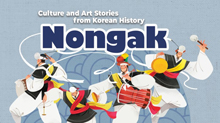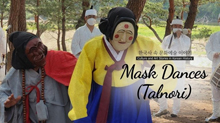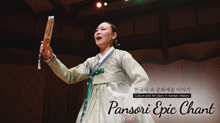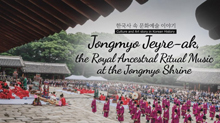The Story of Culture and Arts
- Image resource of Korean history
- Documents from History TextBooks
- Culture & Art Stories from Korean History
- Culture & Art Stories from Korean History - Korean
- National Institute of Korean History
- History net
- About the site
- Introduce
-
Numerous topics related to Korean culture and art are mentioned in middle and high school national history textbooks, but most of them are briefly described by era, making it difficult to understand their concepts, transition processes, and characteristics.
<Culture & Art Stories from Korean History> produces and provides video materials based on expert commentary on the flow, change process, characteristics and characteristics of each major topic in the field of culture and art in Korean history.

Scenario
The dynamic rhythms of gongs and drums, and the exhilarating high-pitched melodies created by pipes. Dozens of villagers dancing in formation, each with their own movements and energy. This stage performance art is called Nongak, or farmer’s music.
Definition and Origin of Nongak
Nongak is a classic example of Korean folk art, a ritual for the village gods performed at New Year’s as a wish for plentiful harvests.
“Nongak is one of Korea’s most time-honored cultural traditions and is very collective in form. It is music, yet also a dramatical performance, yet also a dance, yet also play, but also an offering. It is all of these things, and the very definition of composite art.” Yang Jin-seong / Master of the Imsilpilbong Nongak
We can find performances resembling modern Nongak in records from the late Joseon period.
“The initial trumpet blares confidently. The marching flags face and flutter against each other. The double gongs have a steadiness in their sound, And the drum roars deeply. The melody starts off slow, its tempo gradually increasing to a chaotic cacophony of sound. They move in a dizzying circle, waving their arms and shoulders about in dance.” - Yi Jeongjik (1841~1910) “Nongak”
Nongak Performances
Nongak is not a performance done only by professional musicians. A local troupe native to the village typically learns and performs the songs. The troupe consists of musicians, called chibae, flag bearers called gisu, and several performers called japsaek. Primary instruments are gongs and drums such as the kkwaenggwari, the jing, the janggu, the buk, and the sogo. Sometimes pipes are also included. The leader and conductor of the troupe is called the sangsoe. The sangsoe plays a small flat gong or kkwaenggwari at the front of the troupe. Everyone follows the sangsoe when changing tunes or positions. The sangsoe also has the job of delivering well-wishes and blessings to the assembled crowd.
The sangsoe controls the rhythm of the performance while a large gong or jing is tasked with maintaining the tempo and the overall sound. Several people play the janggu. The first position musician is called the seoljanggu or the sujanggu.(* Janggu : an hourglass-shaped double-headed drum) The seoljanggu dance is a solo performance meant to showcase their skills. The sangsoe leads the janggu player onto the stage, where they will then begin their dynamic solo. The buk, or drum, complements the janggu’s leathery sound while emphasizing the beat. They create the rhythm and flow of the music.
Besides these four instruments, another necessary instrument is the sogo, or small drum. The sogo players’ role is less about the music and more about the spectacular dance that adds flare to the songs. Those performers walking about and dancing in front of the band are called jabsaek. They add entertainment to the Nongak performance by performing different roles, including that of Daeposu and Jorijung.
The Many Names of Nongak
Nongak is called something different depending on the group’s purpose and personality. The most common expression is “gut” or “to perform a gut”.
“Originally, a gut had a much more pronounced social function. When one is working, it is called a dure-gut. When we perform the end of the year ceremony, it is a mae-gut. When we perform a ritual at the beginning of the year, it is a madangbalbi-gut or jisin-gut. When masks are worn, it is called a ‘tal-gut’. A ‘gut’ is a combination of music, song, dance, and ritual offerings.” Yang Jin-seong / Master of the Imsilpilbong Nongak
Dure and pungjang are nongak performed while working.
“The term dure actually means a method of work or a group of workers. When gathering people to go out to work, they play Nongak in the village square, everyone performing together, while heading into the fields. Then they’ll perform Nongak again on their way home after the workday is finished. So dure had this complex meaning of everyone working but also playing together. Another different but similar word for this is pungjang.” Yang Okgyeong / Instructor, School of Korean Traditional Arts, Korea National University of Arts
Regional Variations of Nongak
Nongak is divided into several major regional varieties. These include the Utdari Nongak of Chungcheong and Gyeonggi, the Yeongdong Nongak of Gangwon, the Yeonnam Nongak of Gyeongsang and the Honam-jwado Nongak and Honam-udo Nongak. Each variety has its distinct cultural elements and style.
The Pyeongtaek Nongak Pangut, the major style of Utdari Nongak, has roots in dure Nongak but also adopted the professional performance of strolling troupes. Its unique rhythm and the skill of child dancers also make it stand out.
Reflecting the life of the community, the Yeongdong region’s Gangneung Nongak pangut is centered on farm life and imitates the farming process. The pangut of the Imsilpilbong Nongak of the Honam-jwado Nongak emphasizes group participation and is characterized by its various rhythmic melodies and the open invitation for the audience to join in.
The Iri Nongak of the Honam-udo Nongak features intricate melodic variations, rich rhythms, developed Seoljanggu performances, and varied band formations. The Jinju and Samcheonpo Nongak of the Yeongnam Nongak culture features a prominent drumbeat, quick and energetic melodies that depend on the sangsoe’s lead in perfect time during formation changes and is well known for its hat twirling performance.
Nongak Offshoots
Nongak has no set form; it continues to evolve, changing with society over time. In an agricultural society, Nongak strengthened the bond between villagers and helped bring comfort during arduous work. In the modern era, Nongak has become a performance art. Traveling Nongak troupes have taken their show on the road and even all-female troupes appear. After the introduction of the National Folk Art Competition, Nongak solidified itself as a stage performance.
In the late 1970s, samulnori , a Nongak specially made for the stage, made its debut. Samulnori, featuring only the kkwaenggwari , jing , janggu , and buk , showed the possibility of repurposing Nongak melodies into artistically satisfying stage performances using just the music. With these melodies as its base, Samulnori is now collaborating with various musical genres and creating new music.
Epilogue
Nongak still has a place in our 21st-century lives.
“Pungmul(Nongak) is not something you watch. It is a culture of participation by all. That’s why it’s only enjoyable once I join in.” Yang Jin-seong / Master of the Imsilpilbong Nongak
“Nongak has long had the important function of producing a sense of social intimacy. That’s how I would define it.” Yang Okgyeong / Instructor, School of Korean Traditional Arts, Korea National University of Arts
Nongak has always interacted with the times. It has firmly established itself in Korean history and community, consistently finding its place and role. It is for this reason that, at this very moment, we strongly feel Nongak is a tradition that will live on.







